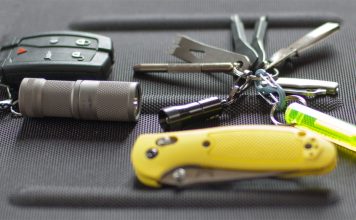 |
|
| Issue #102 • November/December, 2006 |
In Issue #99, I discussed the importance of using the most energy-efficient appliances you can buy for any remote cabin or off-grid solar application. I also mentioned there are several refrigerators and freezers now available that can be powered directly from a 12-volt DC battery. In this issue, I will review several different brands and models of refrigerators, freezers, and combination refrigerator-freezers that will make any rural retreat more like home.
Yes, you can drag an ice chest back and forth on your weekend visits, which is still the most economical way to have ice and refrigerated fresh foods. But for extended or long-term stays, a portable cooler cannot keep ice much longer than a three-day weekend. If your retreat already includes a large propane storage tank to power a cook stove and water heater, then by all means shop for a propane-powered freezer or refrigerator. However, many remote locations are difficult, if not impossible, to access by a propane refueling truck, and electric utility lines may not reach the area, either. For these applications, there are several quality low-voltage refrigerators and freezers that will operate directly from a 12-volt DC battery.
Sizes available
|
Some manufacturers offer units up to 19 cubic feet, which would be equal in capacity to the majority of conventional 120-volt AC refrigerator/freezers you find in most homes. However, I am limiting this review to models in the 4 to 12 cubic feet capacity range, since I assume the refrigeration needs and kitchen wall space are limited in a second home or remote cabin.
For size comparison, 4 cubic feet is slightly larger than a very large portable ice chest, and 12 cubic feet is in the size range of an apartment-size refrigerator. Many of the smaller 12-volt DC models were actually developed for the boating and over-the-road trucking applications. Since both applications have deep-cycle 12-volt DC batteries that are constantly being recharged by diesel engines, energy efficiency is not a primary goal in their design. To minimize space requirements, many of these mobile refrigerators will have thin walls, which reduces the insulation. This type refrigerator has a higher heat gain, which in turn requires more battery power.
If your cabin includes a generator that will be operating every few days, then a less expensive and less efficient model may be your best choice, as regular operation of the generator should keep the battery recharged. However, if you will not have a generator, or only plan to use a generator during an occasional week of bad weather, then keeping the battery recharged using the sun may be your best solution.
For solar charging only, you will want a refrigerator having a very efficient cooling system and very thick wall insulation. Many models I have reviewed have walls with up to four inches of insulation, which can keep food cold for days without power.
Refrigeration system
Many dual-fuel refrigerators are actually modern versions of the old gas absorption refrigerators and use a small gas flame to heat refrigerant gas, which generates the refrigeration process. This means that a unit having both a small propane burner and an electric heating element can separately generate the refrigeration process. Although an absorption-cycle cooling system is fairly simple and does not require any electric motor-driven compressors or a pump, using electrical power to heat anything requires lots of energy. Using an electric heater for generating the refrigeration cycle will require a much larger battery and solar array than the same size refrigerator with a motor-driven compressor.
Another low-cost 12-volt DC refrigerator design uses a solid-state electronic device mounted on a finned-metal heat sink. One side of the heat sink is exposed to the air outside the refrigerated compartment, and the other side is exposed to the inside. These are very low-cost and can be found at almost every truck stop. When connected to a 12-volt DC power source (usually a cigarette lighter outlet), the interior side of the heat sink gets cold while the exterior side gets hot. By reversing the plug, the effect reverses and the interior side heats. In addition to requiring lots of battery power to operate, this device rarely can produce temperatures more than 30° F colder than the surroundings, so an 80° interior truck cab may only result in a 50° refrigerator temperaturenot very useful until colder weather when it may be able to reach lower temperatures.
|
I installed one of these units in my truck that has a 100-watt solar module on the roof, and it ran down the battery any day the engine was not running. I do not recommend using any refrigerator with this type of cooling system for any off-grid application.
One of the most energy-efficient low-voltage refrigerator or freezer designs available uses a brushless 12/24 volt DC sealed motor-driven refrigerant compressor made by Danfoss. When matched up with a well-insulated cabinet, this low-energy compressor usually only operates five to six hours per day to maintain below-zero freezer temperatures.
Since many of the high-efficiency 12 and 24 volt DC refrigerators reviewed in this article use the same Danfoss compressor, their main marketing differences will be cubic feet capacity, thermal insulation thickness, and construction quality. Usually the most energy-efficient models are top-load models, but these are not available in two-door. You can buy a top-load super-efficient freezer or refrigerator, but not both in the same cabinet. Upright door models are usually less efficient than top-load models, but many upright brands offer two-door units that are more useful when you need to keep ice frozen and drinks cold at the same time.
Model comparisons
Since all models reviewed are similar in size, a major cost difference is related to the amp-hour per-day drain on the battery. As stated earlier, if generator or utility grid power is available to keep the battery fully charged, I recommend a lower-cost marine or RV model. However, if a solar panel is the primary power source for recharging the battery, then I strongly recommend a model having a very low amp-hour requirement, and in most cases these will be the most expensive.
The following table provides a basic comparison between several of the most popular 12-volt DC refrigerators, freezers, and refrigerator/freezers currently available. Be sure to read the footnotes as some models were designed for mobile applications requiring built-in cabinetry, some models are top-load only, and some models are short and will require mounting on some type of cabinet base to raise to eye level.
Solar requirements
Unless you live in the very cold northern latitudes having short days and low sun angles, most parts of the United States will average 4 to 4.5 hours of direct sun per day during the winter months and 5 to 6 hours per day during the summer months. Of course, some milder geographic locations may also have lots of rainfall and cloud cover, which reduce these average hourly values.
As an example, if you select a refrigerator or freezer that requires 40 amp-hours per day to operate, this means you will need a solar array that can provide at least 10 amps output (40 amp-hour/4 hours) during the winter, and 6.6 amps output (40 amp-hour/6 hours) during the summer. If your remote cabin or retreat will be used year-round, then you may want to use the smaller sun-hour value. Since the ambient air temperatures are cooler in the winter than summer, all refrigerators and freezers will require less energy to operate during colder months, so a more accurate winter calculation would use the amp-hour load given for lower ambient temperatures.
|
Example:
SunDanzer 5.8 cubic-foot freezer (refer to Table 1)
22.6 amp-hour/day load at 70° F (winter)
36.7 amp-hour/day load at 90° F (summer)
Solar Module Size:
Winter: (22.6 amp-hour)/(4 hours/day sun) = 5.65 amps
Summer: (36.7 amp-hour)/(6 hours/day sun) = 6.12 amps
From the example, we can see how the freezer’s higher cooling efficiency during lower ambient air temperatures can often offset having fewer sun-hours during the winter months.
Finally, solar modules are normally marketed by their nominal nameplate “watts” value. The actual amp output will vary throughout the day as solar intensity changes. If the module’s amp output data is not available, use 16 volts as an average output voltage to convert a solar module’s “watts” rating to “amps.” Also remember the nameplate rating is “peak” output which is hard to achieve unless your site is in the dry desert.
For example, a 100 watt solar modular will provide approximately 6.25 amps (100 watts/16-volts) during each full hour of peak sun, so using the above SunDanzer freezer example; we will require one 100 watt solar module. You will always have some days with less than average hours of peak sun, or even no sun, so adding a second solar module will allow putting more amp-hours of charge into the battery than will be consumed that day. Having extra solar amp-hours going into the battery on a sunny day will carry you through those days with little or no sun.
The wiring diagram shows how a 12-volt DC refrigerator or freezer is wired to a battery and how this battery is wired to a solar module using a solar charge controller. I have also shown the added wiring required to connect a 120-volt AC battery charger that can be powered from a back-up generator or grid-connected wall outlet.
Other issues
In an attempt to provide full disclosure, I purchased both Sun Frost RF-16 and RF-19 refrigerators when we built our solar home in 1994. Both 2-door models include a freezer section with its own separate compressor, which allows each section to operate independently with its own temperature set point. We also purchased a top-load SunDanzer DCF225 freezer in 2003 for added longer-term freezer capacity.
|
I am convinced the Sun Frost models are still the most energy-efficient models you can buy, but over the years we have had to replace door seals, door latches, or shelf brackets every few years. These units also build up ice fairly thick on the back walls during humid conditions. However, their smooth interior walls are easy to manually defrost by just turning them off, removing the food, and blocking the doors open for several hours. This causes the ice to fall off in large sheets that are easy to remove.
I must admit I thought any top-load refrigerator or freezer would be very difficult to use, but the SunDanzer top-load freezer includes several hanging baskets that slide from side-to-side and lift out, which makes it fairly easy to access items near the bottom. We also have very little ice buildup in our SunDanzer freezer. This may be due to its unique internal “air-bladder” design that reduces the amount of humid room air that is drawn in each time the door is opened and closed.
I have not personally used the Norcold and Tundra models, as these are more common for marine and over-the-road commercial truck applications, but they are similar to the refrigerator in our RV. Our experience with this type of combination refrigerator/freezer is they tend to have thinner walls to reduce wall space and less insulation, which increases their energy requirements. However, being designed for mobile applications, these units tend to be fairly durable. We also found that many single-door RV and marine-style refrigerators have a very small freezer compartment located at the top of the interior, which does not freeze foods as solid as separate-door freezers.
Equipment selection
If your primary source to power a 12-volt DC refrigerator or freezer will be a solar-charged battery, then you may find the lowest overall system cost will actually include one of the higher-priced, higher-efficiency refrigerators or freezers. Since a typical solar module in this 100-watt range will cost in excess of $950 each, spending a few hundred dollars more for a more efficient refrigerator may allow you to get by with only one solar module, saving far more in solar system costs, not to mention being able to use a smaller battery.
|
Almost all refrigerator and freezer models reviewed in this article were priced more than $1,000, with the Tundra TJ85 at $1,600, the Norcold DE-61T at $1,200, the SunDanzer DCF225 at $1,100, the Sun Frost RF-12 at $2,100, and the Sun Frost RF-16 at a whopping $2,800. You may be able to find slightly lower prices if you shop around, but all are quality-built low-energy appliances and far exceed the energy performance of lower-cost models you find locally. Since these models are fairly large and some weigh in excess of 300 pounds, they must be shipped to you by truck freight, so expect another $200 for crating and shipping costs.
Other components
The size and type of battery you select will determine how long the refrigerator or freezer can continue to operate without being recharged. Do not use automotive-type batteries, as these have very thin plates and will not last longer than a few months if subjected to a daily charge-discharge cycling.
Using the Sun Frost RF12 as an example with a summer energy usage of 39.0 amp-hours per day, and assuming you do not want to discharge the battery more than 50%, you would need a battery that has a 312 amp-hour rating to store four days of operating time: (39 amp-hours/day)(4 days)(1/50%) = 312 amp-hours.
This equals the storage capacity of a 12-volt size 8G4D diesel truck battery or two 6-volt size T105 golf cart batteries wired together to make 12 volts. A deep-cycle RV/marine battery will also stand up to this kind of service, but its smaller rating of 182 amp-hours will only provide about two days of back-up operation without recharging.
You can expect to pay more than $100 for a quality deep-discharge battery. When shopping for the battery charger, make sure it has an automatic state-of-charge feature that reduces or completely shuts off the charging current when the battery is full. Otherwise, leaving a battery charger connected full-time to any battery will quickly “boil” it dry if the charging current does not lower as the battery’s charge level goes up. Grainger sells a Model #4KC95 Dayton dual 12/24-volt battery charger for $86 that is perfect for this application. Its 10-amp charging output automatically adjusts down to 0 amps as the battery reaches full charge, and it is designed for continuous maintaining of a deep-discharge battery.
I like to use a maximum power-point tracking (MPPT) solar charge controller, which will “squeeze” more charge out of any solar module. The charge controller’s size depends on the size of your solar array. I also like the charge controllers that include a low-voltage disconnect feature and load terminals. This makes wiring much easier and allows the controller to disconnect the load from the battery if the battery-charge level drops below a safe level.
|
Having a low-voltage cut-off on the solar charge controller will make your battery last much longer, and hopefully, there will be enough cold “mass” inside the refrigerator or freezer to carry through a period of limited or no solar charging when the battery is too low. The low-voltage cut-off will also keep your refrigeration compressor from the damaging effects of rapid cycling on and off when the battery voltage is too low to allow it to actually start.
I really like the Morningstar line of solar charge controllers for all small solar arrays. Their 12-volt Sunsaver Model #SS-10L at 10 amp and Model #SS-20L at 20 amp are a good choice for this application. Use the 20-amp controller for solar arrays in the larger 150 to 200 watt size range, and the 10-amp controller for smaller array sizes. They both include the extra terminals shown in the wiring diagram to connect the refrigerator, which provides the low-voltage load disconnect.
Summary
Any of the low-voltage refrigerators and freezers reviewed should meet your needs for this type of application and are available from many different sources. For most brands I am providing only contact information for the manufacturer, who can direct you to a dealer in your area.
Although this article was intended for remote cabins not served by power lines, I have also installed these 12-volt DC freezers in conventional homes located in areas subject to frequent power outages from hurricanes. For many of these applications, a grid-connected battery charger is used to constantly make up the battery drain of a 12-volt DC freezer when utility power is available, which means the battery is never discharged unless there is a power outage.
I have one client who keeps their solar module in the garage, which is only taken outside and set up after a hurricane has destroyed the local power lines, which shuts off their kitchen refrigerator for several weeks. For these grid-connected applications, the 12-volt DC refrigerator, battery, and battery charger are usually located in the basement, garage, or utility room, which only becomes the primary refrigerator during these extended power outages.
Sources
Refrigerators:
Sun Frost
Upright refrigerators and freezers
www.sunfrost.com
SunDanzer
Top-load refrigerators and freezers
www.sundanzer.com
Tundra by Dometic
Upright refrigerators and freezers
www.tundra.cc
Norcold
Upright refrigerators and freezers
www.norcold.com
Polar Power
Upright refrigerators and freezers
www.polarpowerinc.com
Solar Charge Controllers:
Morningstar Corporation
www.morningstarcorp.com
Battery Chargers:
WW Grainger
www.grainger.com
Solar Modules:
Backwoods Solar Electric
www.backwoodssolar.com
Kansas Wind Power
www.kansaswindpower.com
Sun Frost, SunDanzer, Tundra, Dometic, Norcold, Polar Power, Morningstar, Sunsaver, and WW Grainger are registered trademarks.
[weaver_widget_area id=’articles_about_yago’ class=’text3′]





















Any idea as to usefulness of taping more insulation to the door, top and sides of a solar powered fridge? Mine gets a lot of buildup of ice in the fridge compartment, even with great care in minimizing openings. Would more insulation be useful? The outside of the fridge is cool.
Dometic is no longer making thier solar fridge or freezer. I tried calling and was going to order one.
Thanks for these informational articles. I have been giving serious thought on creating a boondocking van. The more one learns, the better the results will be.